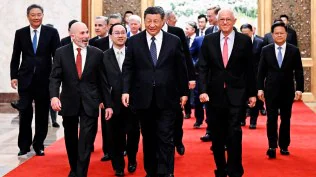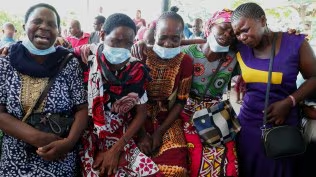Israeli hostage says she was sexually assaulted and tortured in Gaza
Amit Soussana, an Israeli lawyer, was abducted from her home Oct. 7, beaten and dragged into the Gaza Strip by at least 10 men, some armed. Several days into her captivity, she said, her guard began asking about her sex life.
Soussana said she was held alone in a child’s bedroom, chained by her left ankle. Sometimes, the guard would enter, sit beside her on the bed, lift her shirt and touch her, she said.

He also repeatedly asked when her period was due. When her period ended, around Oct. 18, she tried to put him off by pretending that she was bleeding for nearly a week, she recalled.
Around Oct. 24, the guard, who called himself Muhammad, attacked her, she said.
Early that morning, she said, Muhammad unlocked her chain and left her in the bathroom. After she undressed and began washing herself, Muhammad returned and stood in the doorway, holding a pistol.
“He came towards me and shoved the gun at my forehead,” Soussana recalled to The New York Times. After hitting Soussana and forcing her to remove her towel, Muhammad groped her, sat her on the edge of the bathtub and hit her again, she said.
He dragged her at gunpoint back to the child’s bedroom, she recalled.
“Then he, with the gun pointed at me, forced me to commit a sexual act on him,” Soussana said.
Soussana, 40, is the first Israeli to speak publicly about being sexually assaulted during captivity after the Hamas-led raid on southern Israel. In her interviews with the Times, she provided extensive details of sexual and other violence she suffered during a 55-day ordeal.
For months, Hamas and its supporters have denied that its members sexually abused people in captivity or during the Oct. 7 terrorist attack. This month, a United Nations report said that there was “clear and convincing information” that some hostages had suffered sexual violence and that there were “reasonable grounds” to believe sexual violence occurred during the raid, while acknowledging the “challenges and limitations” of examining the issue.
Soussana said she had decided to speak out now to raise awareness about the plight of the hostages still in Gaza, whose number has been put at more than 100, as negotiations for a cease-fire falter.
A spokesperson for Hamas, Basem Naim, said in a response to the Times that it was essential for the group to investigate Soussana’s allegations but that such an inquiry was impossible in “the current circumstances.”
Naim cast doubt on Soussana’s account, questioning why she had not spoken publicly about the extent of her mistreatment. He said the level of detail in her account makes “it difficult to believe the story, unless it was designed by some security officers.”
Soussana lived alone on the western side of Kibbutz Kfar Azza. After hearing sirens warning of rocket attacks Oct. 7, she said, she sheltered in her bedroom, which was also a reinforced safe room.
The small kibbutz was one of more than 20 Israeli villages, towns and army bases overrun that day by thousands who surged across the Gaza border. Some 1,200 people were killed that day and about 250 abducted, Israeli officials say, setting off a war in Gaza that local health officials say has killed at least 31,000 Palestinians.
At 9:46 a.m. that day, she heard gunmen outside, according to messages on her family WhatsApp group reviewed by the Times. Twenty minutes later, her phone died.
Moments later, “I heard an explosion, a huge explosion,” she said. “And the second after that, someone opened the closet door.”
Dragged from the closet, she said, she saw roughly 10 men rifling through her belongings, armed with assault rifles, a grenade launcher and a machete.
The group dragged her through a nearby field toward Gaza. Security footage shows the group repeatedly tackling her as they struggled to restrain her. At one point, a kidnapper slung her across his back. The video shows her flailing so hard that the man tumbled to the ground.
“I didn’t want to let them take me to Gaza like an object, without a fight,” Soussana said.
Finally, her kidnappers bound her hands and feet and dragged her across the bumpy farmland into Gaza, she said.
She was badly wounded, bleeding heavily, with a split lip, she said. The hospital report prepared shortly after her release said that she returned to Israel with fractures in her right eye socket, cheek, knee and nose and severe bruising on her knee and back.
After reaching Gaza, Soussana said, she was shoved into a waiting car and driven into the outskirts of Gaza City. A hood was placed over her head, although she could still catch glimpses of her surroundings, she said.
After the hood was removed, Soussana said, she found herself in a small structure built on the roof of what she would later realize was a private home. The gunmen hurried downstairs, and she was left alone, facing a wall, with a man who said he was the owner of the house and called himself Mahmoud, she recalled.
She said Mahmoud was soon joined by a younger man, Muhammad.
Early in her captivity, her guards chained her ankle to the window frame, she said. Around Oct. 11, she said, she was led by the chain to a bedroom downstairs. The chain was reattached to the door handle, she said.
For the next 2 1/2 weeks in October, Soussana said, she was guarded exclusively by Muhammad.
She said Muhammad slept outside the bedroom but frequently entered the bedroom in his underwear, asking about her sex life and offering to massage her.
After giving her sanitary pads, Muhammad seemed particularly interested in the timing of her period, she said.
“Every day, he would ask, ‘Did you get your period? Did you get your period?’” Soussana recalled.
When it arrived, Soussana said, she was exhausted, afraid and undernourished; her period lasted just one day. She managed to convince him that her menstruation continued for nearly a week, she said.
Early on the morning of the assault, she said, Muhammad insisted she take a shower, but she refused, saying the water was cold. Undeterred, he unchained Soussana and brought her to the kitchen and showed her a pot of water boiling on the stove, she said.
Minutes later, he brought her to the bathroom and gave her the heated water to pour over herself, she said.
After washing for a few minutes, she heard his voice again from the door, she said.
“‘Quickly, Amit, quickly,’” she recalled him saying.
“I turned around, and I saw him standing there,” she said. “With the gun.”
She remembered reaching for a hand towel to cover herself as he advanced and hit her.
“He said, ‘Amit, Amit, take it off,’” she recalled. “Finally, I took it off.”
“He sat me on the edge of the bath. And I closed my legs. And I resisted. And he kept punching me and put his gun in my face,” Soussana said. “Then he dragged me to the bedroom.”
At that point, Muhammad forced her to commit a sexual act on him, Soussana said. After the assault, Muhammad left the room to wash, leaving Soussana sitting naked in the dark, she said.
When he returned, she recalled him showing remorse, saying, “I’m bad. I’m bad. Please don’t tell Israel.”
Soussana said her captors moved her away from the border after a major bombardment. Based on the extent of the explosions and snippets she caught on television, she later concluded it was around the start of Israel’s ground invasion of Gaza on Friday, Oct. 27.
On the following day, she was hurried into a small car, she said. The driver headed toward what she would later be told was the city of Nuseirat.
The car stopped outside what looked like a U.N. school, and Soussana said she was handed over to a man who called himself Amir. He marched her up the stairs of a nearby apartment block and into another private home, she said.
The man ushered her into a bedroom and shut the door behind her, she recalled. Inside, she found two young women playing cards, next to an older man lying on a bed and an older woman sitting in a chair, she said. Soussana had been united with four other hostages.
A few days after her arrival, she was summoned to the apartment’s living room, Soussana recalled.
On that day, the guards wrapped her head in a shirt, forced her to sit on the floor, handcuffed her and began beating her with the butt of a gun, she said.
After several minutes, they used duct tape to cover her mouth and nose, tied her feet and placed the handcuffs on the base of her palms, she said. Then she was suspended from a stick stretching between two couches, causing her such pain that she felt that her hands would soon be dislocated.
They carried on beating and kicking her, focusing on the soles of her feet, while simultaneously demanding information they believed she was hiding from them, Soussana said.
She still doesn’t understand what exactly they wanted or why they thought she was concealing something, she said.
“It was like that for 45 minutes or so,” she said. “They were hitting me and laughing and kicking me, and called the other hostages to see me,” she said.
In mid-November, the hostages were separated: The two youngest women were taken to an unknown location, she said, while Soussana and the older couple were driven to a house surrounded by farmland.
They found the house full of gunmen, who ordered them to sit on the floor. Suddenly, the older woman began to scream, Soussana said.
The woman was looking into a shaft that descended into the ground, Soussana said. “I hear one of the drivers telling her, ‘Don’t worry, don’t worry. It’s a city down there.’”
“Then I realized,” Soussana said. “We’re going into the tunnels.”
By the time they reached the bottom, the guards said they were 40 meters (more than 130 feet) deep. Soussana said a big gunman in a mask was waiting for them there.
Their captors spent little more than an hour a day in the tunnel, ascending to higher levels overnight for fresh air, Soussana said. The hostages pleaded with the guards to bring them, too.
After several days, the kidnappers brought them back to the surface and drove them to another private house, Soussana said.
They were still there when Israel and Hamas agreed to a hostage deal and a temporary truce, which went into force Friday, Nov. 24. The following day, the three hostages were driven to an office in Gaza City.
On Thursday, Nov. 30, the guards were making lunch when one of them finished a phone call and turned to Amit.
“He says, ‘Amit. Israel. You. One hour,’” Soussana recalled.
Within an hour, Soussana said, she was driven through Gaza City. The car stopped, and a woman in a hijab climbed inside. It was another Israeli hostage: Mia Schem, who was also being released.
As they approached the Israeli border, a female Red Cross official handed Soussana a phone. A person who said he was a soldier greeted her in Hebrew.
“He said, ‘A couple more minutes, and we’re going to meet you,’” Soussana said. “I remember I started to cry.”
Disclaimer: The copyright of this article belongs to the original author. Reposting this article is solely for the purpose of information dissemination and does not constitute any investment advice. If there is any infringement, please contact us immediately. We will make corrections or deletions as necessary. Thank you.





